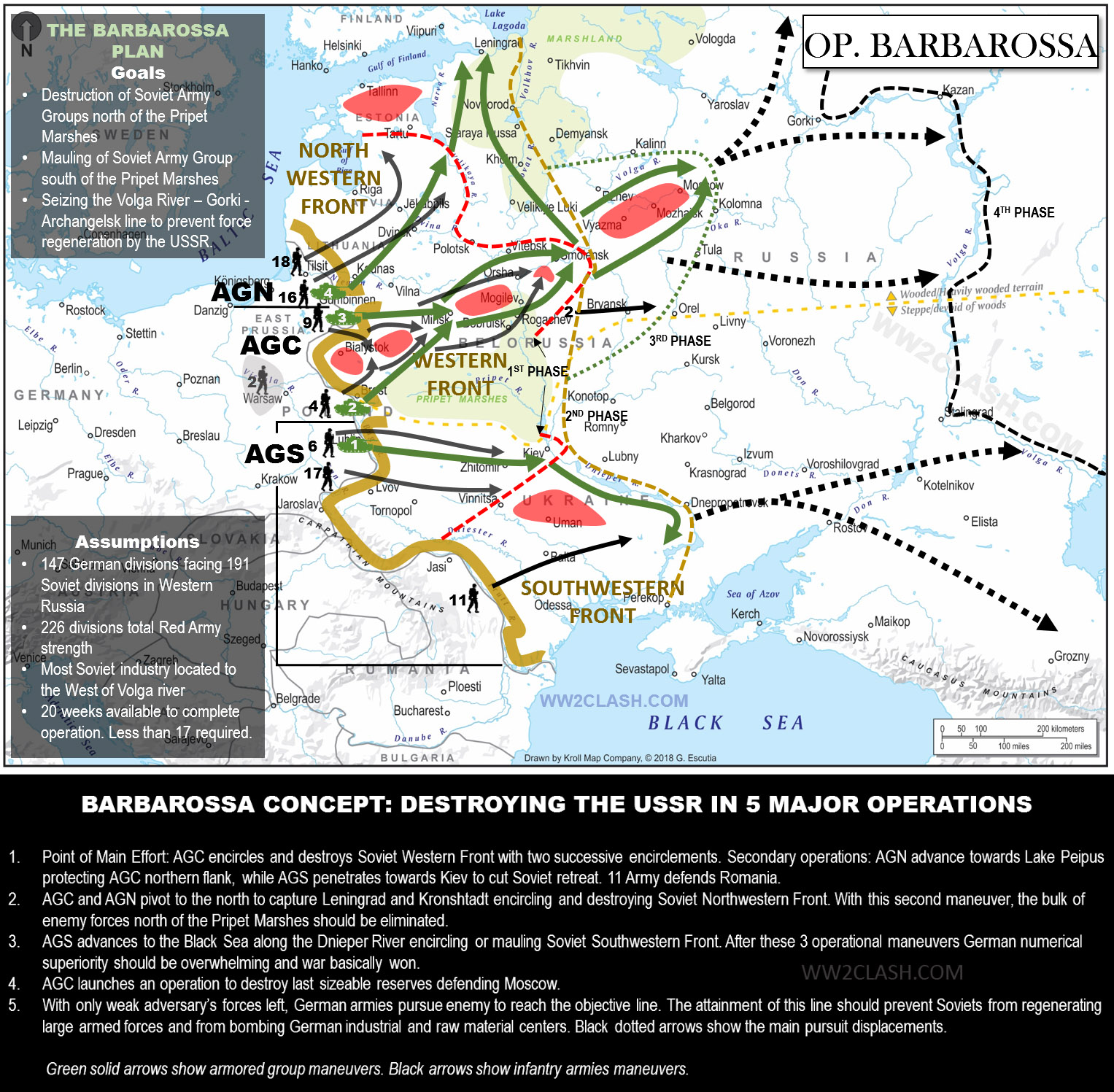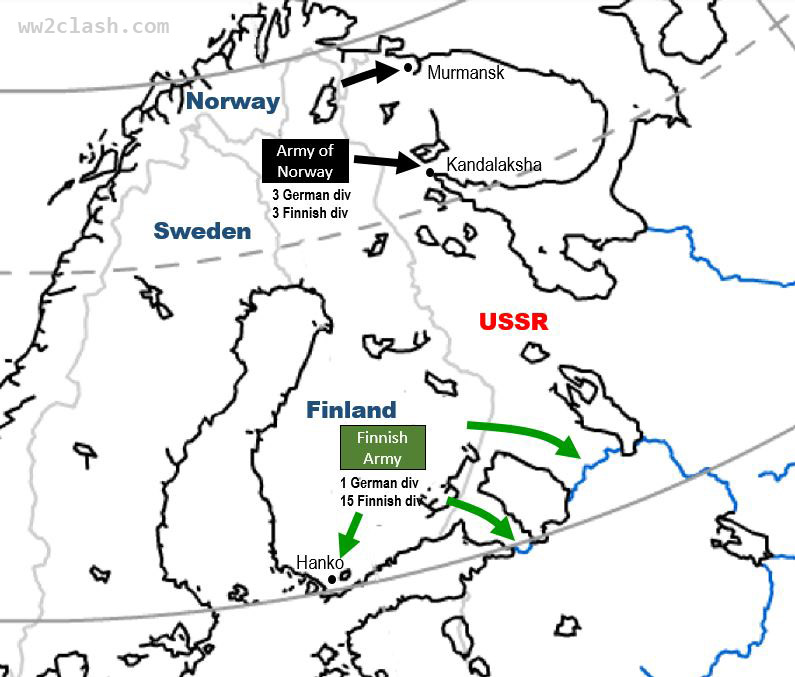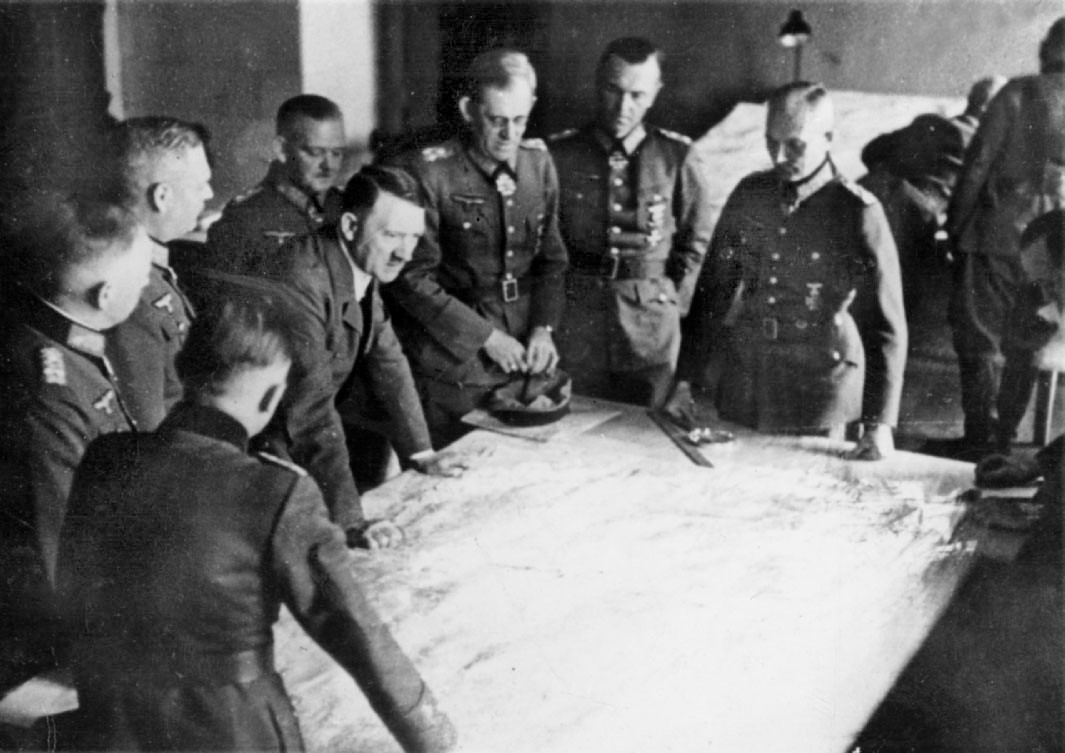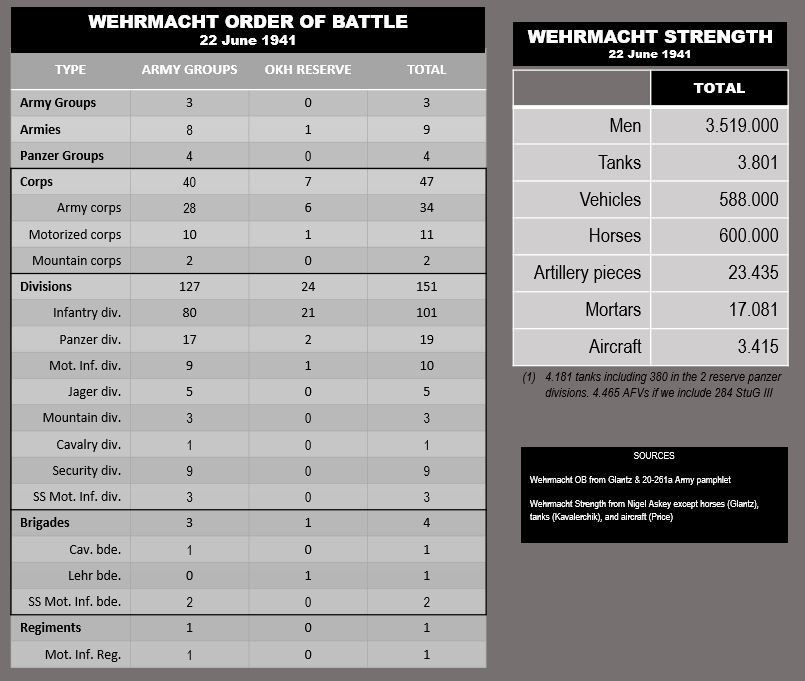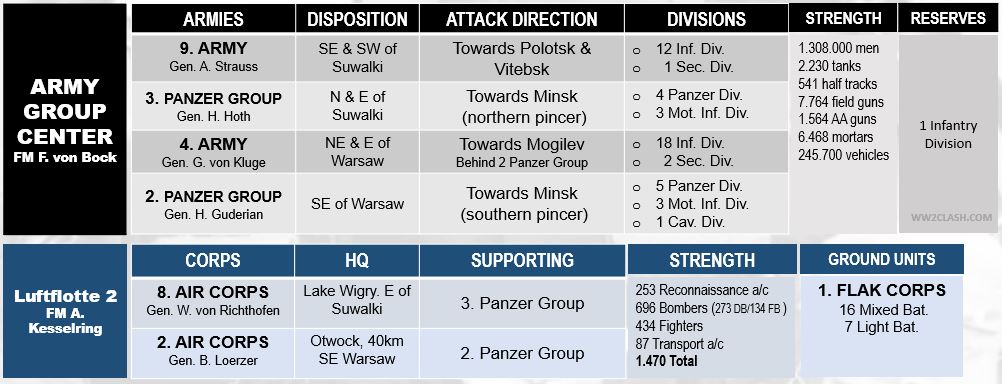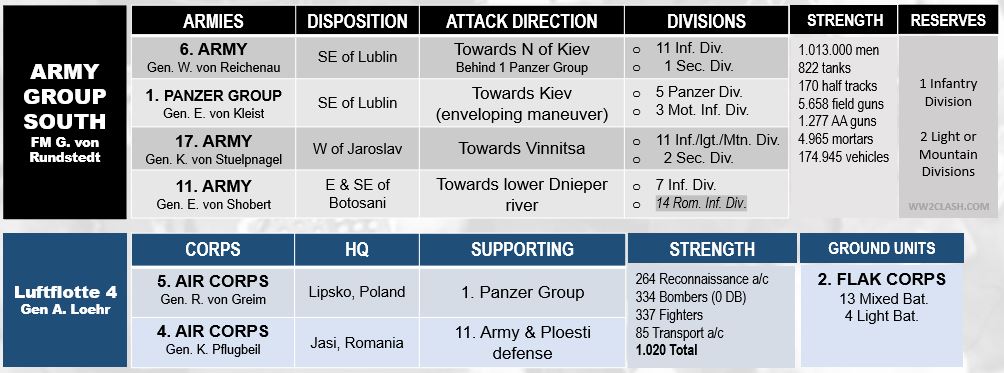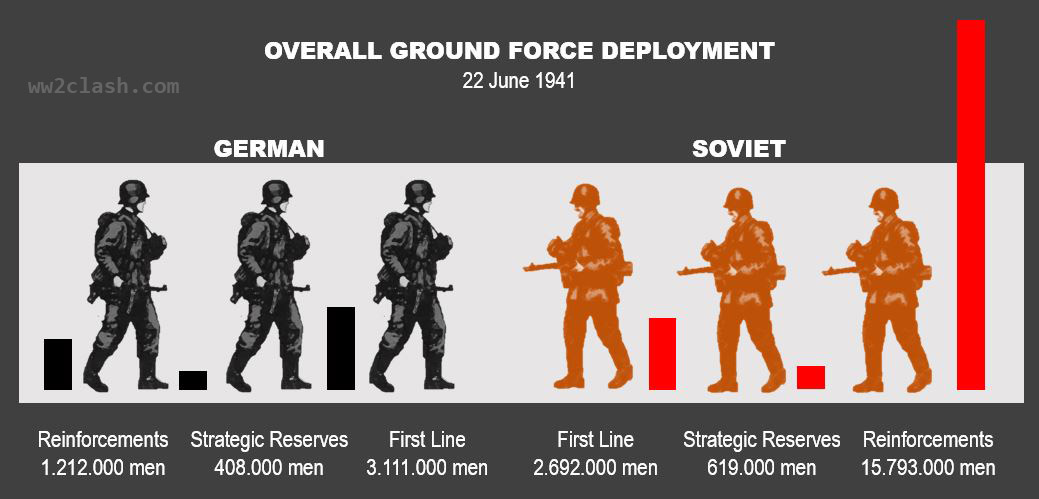FINAL BARBAROSSA PLAN
Barbarossa was a bridge constructed over sand. The ineffective intelligence service of the German Army provided flawed data to the planners who based on it, arrived at erroneous conclusions: first, the size of the Red Army proved to be much greater than anticipated with the consequence that the size of the German Army, including projected replacements, was insufficient to destroy the Red Army in a short summer campaign , and second, the occupation of western Russia could not prevent the Soviet state from generating large quantities of new combat formations and thus it could continue waging a high-intensity war for years.
The OKH’s planning process lacked checks and balances to detect and correct these defects on time.
These fundamental errors stacked the odds heavily against the Third Reich even before the firing of the first shot, because the Germans prepared for a gigantic battle but not for a long-term attrition campaign.
The reasons for the ultimate failure of Barbarossa are, firstly, robust preparation for war on the part of the Soviets while the Germans made no back-up arrangements for facing the uncertainties present in a war , and secondly, the swift adaptation of the Russians to the actual conditions on the ground once they identified the mistaken expectations they made at the start, while the German corresponding response was sluggish and misdirected . The fog of war renders decision-making a messy affair, but the Russians demonstrated to be a match to the task whereas the Germans were not.
However, against all odds, the initial blow the Wehrmacht delivered seriously shook the Soviet building to the point that the Red Army’s collapse became a possibility in 1941. It is important to understand how the Germans were trying to accomplish the destruction of the Soviet State, so we can identify where they made intelligent or reckless decisions, and if they could have changed history.
Based on the plans approved by Hitler on 5 December, the OKW set itself to write a directive. The purpose of a directive is to lay out the goals of a specified campaign and the overall strategy that the armed forces would abide by to accomplish such goals. The directive is the foundation over which each of the branches of the armed forces developed their operational plans ensuring proper coordination. A directive was not a binding order for war, but it gave instructions to start all necessary preparations for their completion in time in case it was necessary to implement it.
On 12 December, days before the approval of the directive, Admiral Raeder issued another report with strong objections to the new campaign, stressing that the defeat of Great Britain should be the priority. He was ardently trying to dissuade Hitler. But by this time, Hitler had made up his mind , and he responded to Raeder that the navy and air force would receive priority after Russia’s defeat.
The dictator received the directive for his approval on 17 December 1940, but he did not sign it until the next day under the title Operation Barbarossa (Unternehmen Barbarossa) . He explicitly modified the original draft adding the important amendment that the capture of Leningrad and Kronshtadt along with the destruction of the enemy forces in the Baltic was the priority. Upon seizing these objectives, the advance on Moscow would resume and not before. He would only allow both forward movements to proceed simultaneously if the Red Army had collapsed already .
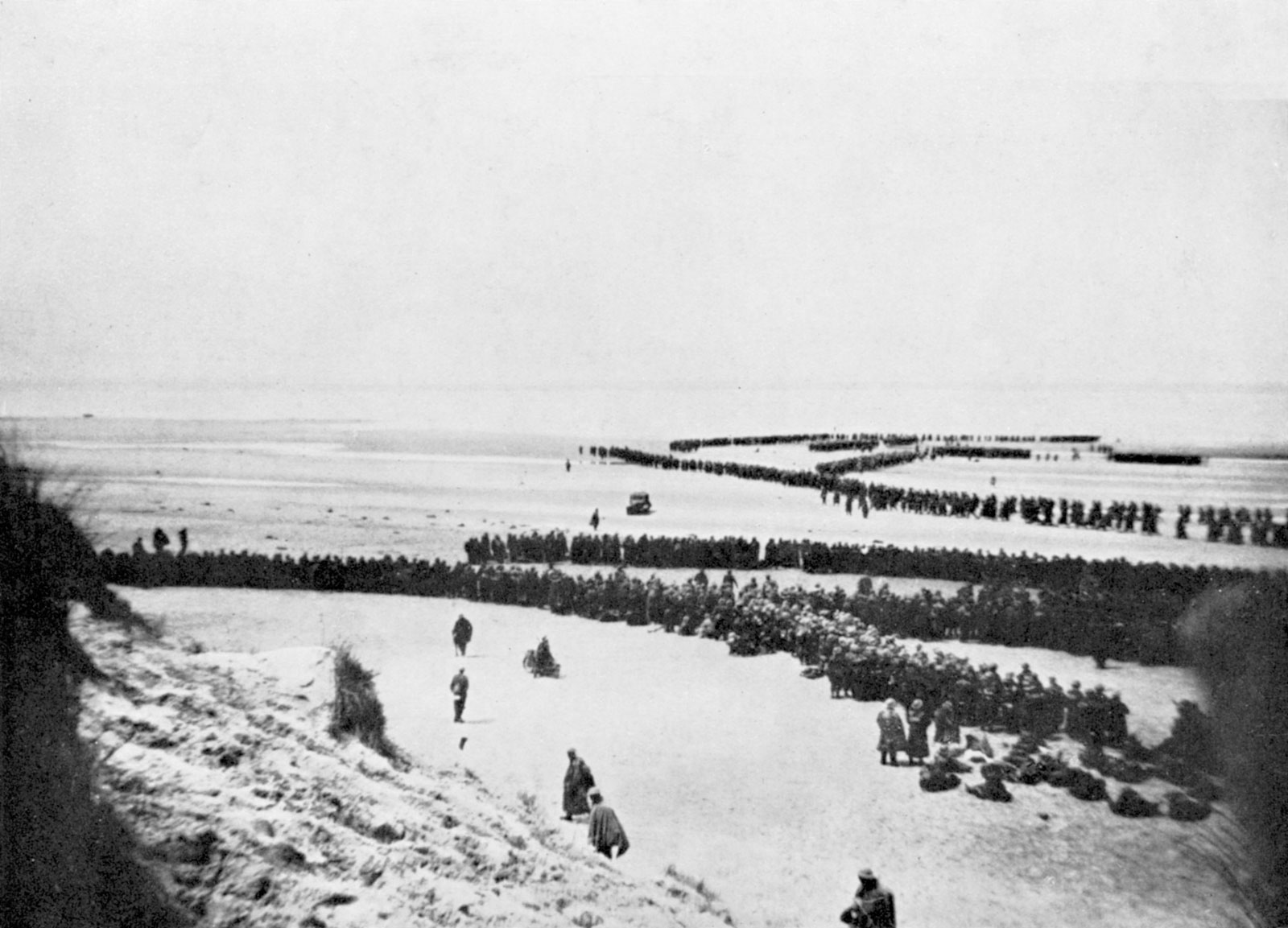
This change was not a surprise to von Brauchitsch, or Halder since Hitler’s arguments were a restatement of his instructions during the 5 December conference.
The ensuing Army Order, detailing the operational implementation of the directive by the ground army, would suffer an important alteration in the southern sector of operations after intense debate. Both, the Directive, and Army Order took their final form until April 1941, just weeks before the invasion.
The concept behind Barbarossa was analogous to the Sichelschnitt plan to defeat France: the rapid destruction of a substantial portion of the enemy’s army to achieve a decisive numerical superiority in subsequent phases . This concept makes perfect sense if the enemy is quite constrained in its ability to raise new forces .
Sichelschnitt contemplated 2 stages: the first was the encirclement and destruction of the British and French troops deployed in northern and northwestern France and Belgium.
After the elimination of this pocket, the Germans, enjoying now a substantial numerical superiority, could more easily pierce the new French defensive line in the Somme-Aisne rivers, and penetrate deeply in the enemy’s rear areas overrunning the whole country. The plan was overwhelmingly successful and in Barbarossa, the Germans projected to repeat the general formula .
The Germans knew that the Russians, taking advantage of the difficult geography of their country, faced the previous French invaders with a defense that consisted of fighting delaying actions that forced the aggressor to penetrate the country to the limit of their supply lines without engaging in a decisive battle. Once their supply state was unreliable, the Russians mounted counteroffensives to destroy or expel the overextended attackers.
The German Staff considered that this time, such strategy was unworkable because it would mean the abandonment of their most important industrial centers, situated east of the Dvina and Dnieper Rivers. These centers were necessary to produce munitions to replace losses and continue the fight .
Additionally, the German planners believed, incorrectly, that the bulk of the Soviet army had deployed at the frontier, although it was impossible to say if it would defend the border forcefully or if it would retreat slowly until it reached the Dnieper River. Barbarossa attempted to force a decision by using fast-moving, deep armored penetrations strongly supported by the Luftwaffe to prevent the large-scale retreat of the Red Army .
The final directive of April 1941 envisaged the deployment of 3 powerful army groups: Army Group North (AGN) and Army Group Center (AGC) to the north of the Pripet Marshes and Army Group South (AGS) to the south of this barrier .
The mass of the German troops would occupy positions in East Prussia and Poland. The two northern army groups assembled between Tilsit and Brest-Litovsk, while the bulk of Army Group South deployed between Lublin and Jaroslav (see next map). This remarkably concentrated grouping minimized the distance between the forward troops and the supply centers in Germany and facilitated force deployment and store distribution because the best road and railroad networks were situated in this area.
The remainder of the troops of Army Group South deployed west of the Prut River, along with Romanian troops , but these forces would not join the attack until after Barbarossa had gained momentum and would remain in a defensive stance without crossing the border . The distance from Romania to the German supply centers was considerably longer and over a less well-developed communication network, so only one German army (the 11th Army) occupied positions there.
The frontage from Memel (north of Tilsit) to Jaroslav was not overly extensive, about 1.100 km (700 miles), making it only 20% longer than the French front a year earlier. This allowed the German divisions allocated to this sector to assemble in depth. Successive waves were fed consecutively behind the previous ones as the extension of the front increased.
Nevertheless, this front would surge to over 2.100 km (1.350 miles) very rapidly due to the funnel shape of the Soviet Union. This vast arena would exceed anything experienced by the German arms in previous offensives. If, as expected, the Wehrmacht achieved numerical superiority over the Red Army by the time its forces reached the Dnieper River, the Russians would find it impossible to defend this immense combat zone.
The main objective of the offensive was the destruction of the Red Army troops north of the Pripet Marshes and the mauling of those south of it. The secondary objective was to reach the Volga River from the Caspian Sea to Gorki and from there to Archangelsk by the White Sea in a roughly straight line, preventing (it was hoped) any possibility of force regeneration by the Soviet state. The destruction of the bulk of the Russian forces would occur in three stages followed by a pursuit stage to reach the objective line.
The point of main effort fell in the sector assigned to Army Group Center. This army group divided his forces into 2 powerful clusters into its wings. To the right, the 2nd Panzer Group was to form the southern arm of a pincer that would jump off from assembly areas in and around Brest-Litovsk to drive directly in the direction of Baranovichi-Minsk, followed by the infantry divisions of the 4th Army (see next map).
At the same time, the 3rd Panzer Group would attack from the Suwalki area forming the northern pincer of a double envelopment. It would push towards Molodechno to link with the 2nd Panzer Group around Minsk. The infantry corps of the 9th Army would follow on the tracks of the armored divisions of the 3rd Panzer Group and along with those of the 4th Army to the right, would consolidate the ring around Minks while simultaneously closing a smaller envelopment around Bialystock. These infantry corps would then proceed to the destruction of the encircled forces of the powerful Soviet Western Front. A complete air fleet, Luftflotte 2, would lend its support to Army Group Center with two Fliegerkorps, the 2nd, earmarked to support the 2nd Panzer Group and the 8th, backing the 3rd Panzer Group. This air force was the most powerful of the four air fleets assigned for the invasion and included all the dive bombers and low-altitude fighter-bombers deployed by the Luftwaffe . This conferred Luftflotte 2 the ability to carry out intense and very high-precision attacks in the Soviet rear. The panzers would be defended by the heaviest concentration of fighters and the strongest anti-aircraft corps.
With the destruction of the larger part of the Soviet Western Army Group completed, a huge gap in the Soviet defensive system would materialize; the two Panzer groups would then renew the advance to reach Smolensk from the southwest and the northwest, preventing the organization of a solid defensive line in the Dnieper River sector and would encircle the remnants of this Soviet army front. After the mop-up operations in the Minsk pocket, the 4th Army would proceed to force a crossing of the Dnieper at Mogilev, via Bobruysk and Borisov, while the 9th Army would cross the Dvina at Polotsk. Both infantry armies would then smash the encircled Red Army troops in the new pocket. The Smolensk operation should complete the destruction of the Soviet Western Front.
At this stage, the German advance in the center should be ahead of the army groups to its left and right and Army Group Center would stop, ready to pivot to the north to encircle the Soviet Northwestern Front that would be fighting against Army Group North.
At the outset of the operation, Army Group North focused its main effort in the right wing where the 4th Panzer Group, deployed near Gumbinnen, would push towards the Dvina River at Dvinsk and from there to the south of Pskov on the shores of Lake Peipus. This advance would protect the left flank of Army Group Center by sweeping the Russian forces to the north, creating a concentration of enemy troops in this area (belonging to the Soviet Northwestern Front).
16th Army, on the same right-wing, would advance behind the 4th Panzer Group toward Pskov. Simultaneously, the 18th Army on the left would push along the Tilsit-Riga highway crossing the Dvina River at Yekabpils and would destroy the forces southwest of Riga.
AGN would receive the support of Luftflotte 1 that had reserved the 1st Fliegerkorps to help the advance of the 4th Panzer Group and Fliegerfuhrer Baltic on the left, to assist the operations in the Baltic coast by 18th Army.
Upon reaching this stage, 3rd Panzer Group from Army Group Center would swivel to the north along with 4th Panzer Group to envelop the forces of Northwestern Front against the Gulf of Finland, capturing Leningrad and Kronshtadt in the process. 16th and 18th armies would then proceed to clear Estonia and destroy the encircled formations. This second massive operation would result in the complete annihilation of the Northwestern Front, the elimination of the Russian Navy and the establishment of a link with the Finns.
With these sequential operations, the German High Command expected to eliminate the bulk of both the Western and Northwestern Fronts. These powerful fronts, it was anticipated, had the greater part of the divisions deployed north of the Pripet Marshes. If successful, these maneuvers promised to confer the Germans an overwhelming numerical superiority going forward. The Russians would have enormous problems to reconstruct a continuous defensive line because they would not have enough troops for an adequate defense in depth along such a large frontage .
To the south of the Pripet Marshes, Barbarossa envisaged a secondary but ambitious operation in the original directive of December 18. Army Group South planned a double envelopment with a northern pincer jumping off from Lublin spearheaded by the 1st Panzer Group and a southern pincer launched from Romania spearheaded by a panzer corps attached to the 12th Army. These two pincers would close on the west bank of the Dnieper near Dnepropetrovsk. However, intense discussions followed and Hitler and the OKH abandoned this plan on 18 March. The concern was that a frontal attack by the 12th Army against the Dniester River would take too long to develop, making the expected double envelopment impractical. The crossing of the Meuse River in France a year earlier had required very strong air support and the most powerful armored corps available, neither of which would be on hand for this maneuver.
The definitive plan foresaw a single envelopment using a very strong left wing led by the 1st Panzer Group that would thrust itself in the direction of Kiev and then would wheel southeastwards along the Dnieper River until it reached the mouth of this river in the Black Sea, trapping the Southwestern Front forces to the west of the waterway. This axis of advance would permit to attack the Russian forces deployed in the Dniester River from the flank instead of frontally.
6th Army would advance rapidly behind the panzer group in the direction of Kiev protecting the armored group’s flank along the Pripet Marshes, and then it would redirect strong forces in a southeasterly direction along the Dnieper River, thus protecting the long-left flank of the panzer group.
17th Army in the center would advance in the direction of Vinnitsa and Berdichev preventing the Russians from breaking contact and from withdrawing rapidly to the East bank of the Dnieper River.
The 12th army initially contemplated to attack from Romania would now stay in Greece after the Balkan campaign to control the occupied territories so the OKH designated the 11th Army to take its place. This latter army would deploy in Romania, in a purely defensive mission, preventing the Russians from capturing the Ploesti oilfields. Once the attack on the left wing gained momentum the 11th Army along with the Romanian Armies would spring from their positions in a northeastward axis to cross the Dniester River and pin the Soviet forces there, helping to delay the retreat of the red forces across the Dnieper . Luftflotte 4 would support the Army Group South effort with 5th Fliegerkorps allocated to 1st Panzer Group and 4th Fliegerkorps buttressing 11th Army and defending the critical Ploesti oil refineries.
From the beginning, the OKH realized that the chances of success of this southern envelopment were lower than the one planned in the center. If the Russians reacted swiftly, major portions of their forces would escape. But even under this scenario, the Southwestern Front would suffer a nasty battering.
The diverging axis of advance proposed for Army Group Center and Army Group South implied the danger of a large gap developing between these two large forces. Therefore, Barbarossa planned to keep in reserve the 2nd Army to insert it between both army groups to act as the linkage between these formations while simultaneously protecting the right flank of 2nd Panzer Group which would otherwise be in the air once the Pripet Marshes were behind.
To keep the momentum and to protect against surprises, strong German reserves deployed east of Warsaw (near the area occupied by 2nd Army) and west of Jaroslav (behind 17th Army) and weaker ones around Lublin (behind 6th Army) and East Prussia (behind 18th Army).
The combination of those colossal operations, north, and south of the Pripet Marshes, should win the war. Whatever forces remained after these gigantic blows would be insufficient to stop the now numerically superior invaders from overrunning much of the country.
The Germans expected to annihilate the last important reserves in a subsequent push to capture Moscow, followed by pursuing operations to liberate the economically important territories of the Donets Basin and the Caucasus oil fields, thus preventing the projection of Russian power for the foreseeable future.
As explained, the capture of Moscow was incidental to the destruction of the last reserves and in no way the planners conceived Barbarossa as a race to capture this city.
The deployment of this huge army would require 8 weeks and after mid-April, it would be impossible to conceal the assemblage from the Russians . The D-day was set for 15 May 1941. Given that Hitler signed this directive on 18 December, he gave the army, air force, and navy 5 months to finalize preparations.
One peculiarity of the command arrangement of the panzer groups is that these groups were not autonomous armored armies, but they operated as the mobile offensive element of the infantry armies. 4th Army commanded 2nd Panzer Group, 9th Army commanded 3rd Panzer Group, 18th Army commanded 4th Panzer Group, and 6th Army commanded 1st Panzer Group. This command organization was not optimal because the infantry army commanders had to divide their attention between the actions of the panzer troops forward and the infantry divisions rearward. The command structure of AGN was even more unusual because the 18th Army was operating in a different axis of attack from 4th Panzer Group’s. The infantry army chiefs had little expertise leading armored troops and would soon clash with the more impetuous panzer commanders.
The OKH appreciated the relative ineffectiveness of this arrangement a few weeks after the onslaught and it modified the command structure, renaming the panzer groups as panzer armies and making them take their orders directly from the army group they belonged.
The Far North
Barbarossa included subsidiary operations in the Far North. The OKH divided Finland, a secondary theater of operations, in a northern sector commanded by the Germans and a southern sector commanded by Field Marshal Gustav Mannerheim, Commander in Chief of Finnish armed forces.
The German forces in the north planned two offensives: one to capture Murmansk, preventing future aid from the British in the form of weapons or troops. The other in the direction of Kandalaksha to cut the lines of communication to the Russian troops stationed in Murmansk.
Finnish forces would attack along three axes: Hanko, eliminating this important Russian navy base, and to either side of Lake Ladoga to establish a link with Army Group North.
The Luftwaffe
On 20 February, two months after the approval of the Barbarossa directive, Goering set up a planning staff near Berlin to devise the Luftwaffe operational plan that best supported the Army plan. Colonel Loebel coordinated the planning team and from this group, one of the most successful plans in the history of air warfare would emanate. Much of the credit belonged to General Otto Hoffman von Waldau who led the Luftwaffe Operations Department under the Luftwaffe’s Chief of Staff General Hans Jeschonnek at the time . This was fortunate for the Germans because the success of the blitzkrieg depended decisively in the control of the air.
The strategy of first obtaining air supremacy by defeating the enemy air force and later supporting the ground units through interdiction attacks to roads and railroads in the rear areas and by attacking enemy troops in the battle zone, so effective in the previous campaigns, would remain the guiding principle.
Luftwaffe intelligence compiled a precise photo reconnaissance geostatistical study of most of the airfields present in western Russia and correctly assessed the lower operational skills of the enemy air force.
However, its appreciation of the enemy’s air force strength was very poor, underestimating the actual VVS’s size by almost 140% (8.000 planned vs. 19.000 actual).
The Battle of Britain demonstrated that the most effective ways to destroy enemy aircraft on the ground were through dive-bombing, low-altitude horizontal bombing, and strafing attacks launched by surprise. Medium and high-level bombing evidenced ineffectiveness. To improve bombing accuracy, the raid had to come to an end before the enemy fighters intercepted the attackers.
The type of bombs selected was important. The 50kg bombs used in 1940 against airfields, although effective for destroying hangars and light buildings, were unsatisfactory against well-dispersed aircraft. The tactic of dispersing airplanes consists of not parking the aircraft in rows. When attacking the well-dispersed aircraft in British airfields, the Luftwaffe found that most of the bombs were wasted.
The German air force devised the answer to this problem with the invention of its first cluster bomb, the SD 2, or (2-kg) butterfly bomb. Bombers and fighter-bombers could carry dozens of these nasty eggs and release them in copious quantities over much wider areas (rather than point locations). Each bomblet had a destructive radius of 12 meters (40 feet) and was powerful enough to destroy or disable an aircraft .
The reckless confidence of the German leadership on the Luftwaffe was so high that they did not commit its full force for the Barbarossa operation. The directive explicitly stated that the Luftwaffe had to continue carrying out operations against the British while simultaneously supporting the invasion of Russia. In this manner, almost 30% of the Luftwaffe force structure would remain in other fronts, particularly in the Mediterranean where Fliegerkorps X deployed as many aircraft as Luftflotte 1.
Gen. Otto Hoffman von Waldau strongly opposed this dispersion of effort stressing that the Luftwaffe could not support two fronts simultaneously . Time proved him right.
GERMAN STRATEGIC BLUNDERS
Compared with DP-41, Barbarossa comes out the worse. Operationally, while the Soviets overestimated the enemy force and then prepared for it by procuring an army whose size was larger than the minimum necessary to defeat the invasion, and then they set the conditions to sustain a long war with atrocious losses, the German Army and leadership did the opposite. They badly underestimated the enemy’s strength, the length of the war, and the expected losses.
But war is waged not only at the operational level. Grand Strategy and Strategy help or hinder a country’s fortunes contingent on how well the leader plays its cards compared with his opponent.
At the level of Grand Strategy Stalin followed a bullying doctrine: ready to attack small countries while avoiding war against the big powers, unless he had every advantage . For the same reason, he prudently made every effort to avoid becoming entangled in a two-front war with powerful neighbors.
This policy provoked than when the war came, a host of smaller nations would be on the enemy side, but on the positive side, no big power would support Germany.
The Soviet dictator would also ruthlessly mobilize his military-industrial complex to increase manifold his munitions output.
Hitler had other potent levers at his disposal that could compensate for the errors in his operational planning and solidly place the odds back in his favor.
Unfortunately for him and the German people, the evidence is consistent with the assertion that he lacked a solid Grand Strategic outlook, especially when things were in his favor.
Hitler had four major choices. Each one could have had a major positive impact in Germany’s fortunes:
First, Germany was a mightier industrial power than the Soviet Union . It could out produce the USSR in armaments and had an edge in some key technologies (i.e. radar, aeronautics, optics, aluminum production, machine tools). Hitler had the option to mobilize the whole German population and other European peoples for the benefit of his armies before the invasion.
Second, an assault in conjunction with Japan would have placed a tremendous strain on the Russian colossus. Hitler could have attempted to weld Germany and Japan into a military alliance because Japan would also benefit from the defeat of the Soviet state.
Third, a strategy for breaking up the Soviet Union was feasible. Clausewitz had recommended this course of action previously , recognizing the challenge that the immense size and population of Russia entailed. The Soviet Union had internal conflicts with Ukraine, Belorussia, and other peoples who were quite willing to ally with the Germans if offered independence and support. At best this would have provided millions of allied soldiers, at worst, supply would have been strengthened.
Lastly, although Stalin rebuffed Hitler’s proposal for an alliance, Germany was not forced to invade Russia even though Moscow posed and obvious danger. A strained partnership between both dictators, if an alliance was out of the question, would have been preferable for both than a long war. This would have required a thorough reinforcement of Germany’s vital supply centers to defend them if necessary and an aggressive offensive over Great Britain in line with Raeder’s strategy .
Communism and Nazism challenged the Capitalist system and the status quo in the 20th Century. British imperialism, however, proved more astute by driving the two authoritarian systems towards auto-destruction, although at the cost of conceding worldwide supremacy to the Americans. Both dictators despised the western democracies, but the Americans outsmarted them all (Great Britain included) .
By not implementing any of these strategies, the odds remained firmly against Hitler.
German Force Deployment
To implement Barbarossa the Germans assembled a force of unprecedented dimensions: 3.519 Million men , 3.801 tanks , 3.415 aircraft, 17.081 mortars, 23.435 artillery pieces (anti-tank, anti-aircraft, and field guns), more than 588.000 motor vehicles and prime movers, and 600.000 horses organized in 151 divisions and several smaller formations (see table below) . Adding the forces of their allies, 325.000 Romanians and 500.000 Finns, the total figure of attackers exceeds 4.344 Million men.
Only a fraction of the 4.3 million men would see action on the day of the attack. The Romanians, The Finns, 11th Army’s 7 divisions, the 24 divisions in OKH’s reserve, and 5 divisions in Army Group’s reserve did not take part initially. Also, at the army level, commanders kept troops in standby (for instance, Guderian kept 2 mobile divisions and 1 motorized regiment as his Panzergruppe reserve). Therefore, only about 2.1 million men participated in the first day’s attack.
These figures are relatively precise, but we can still find some discrepancies depending on the source. This problem is partly the result of what the historians choose to count.
For instance, the number of 3.519 million German soldiers comprises the forces assigned to the three army groups, the troops arrayed in Finland, all the reserves (including those in transit), Waffen SS troops, Luftwaffe ground personnel, naval coastal artillery, and railroad troops. If we subtract the Luftwaffe’s ground personnel (220.700 men), the initial German army force numbers about 3.298 million. In his diary, Halder gives 3.2 million as the initial strength of the German army , so we can be fairly sure that the number is close.
The Heer (or German Army) deployed these 3.298 million men in 101 infantry divisions, 19 armored divisions, 13 motorized infantry divisions (including 3 SS formations), 9 security divisions, 9 other types of divisions, as well as other smaller formations.
Organizational Deployment to the Army Groups
For the initial border battles, OKH assigned Army Group Center, under Generalfeldmarschall Fedor von Bock, the responsibility to launch the main attack (Schwerpunkt). Consequently, the High Command allocated the best-equipped units to it.
This Army group included the bulk of the German divisions (50 of the 127 for the initial attack, or 40%) and most of the armored divisions (9 out of 17, excluding the two in reserve, or 53%). His panzer formations not only had most of the tanks, 2.230 out of 3.801 or 59% but enjoyed the largest share of the best tanks in the German inventory, 57% of all the Panzer III and IV deployed by the Germans.
Even more important was the support of the Luftwaffe for this army group. The two Fliegerkorps assigned to Luftflotte 2 of Generalfeldmarschall Albert Kesselring comprised between them 696 bombers (serviceable and unserviceable) out of 1.438 available for the invasion (48%). Notably, 100% of the low-level fighter-bombers (134) and 87% of the dive bombers (273) belonged to this Luftflotte. This allowed both Fliegerkorps to mount a sustained high-precision attack campaign, a capability denied to the neighboring Luftflotten that only deployed twin-engine bombers. The use of the less maneuverable bi-motor bombers implied a higher loss rate when they operated over the battle zone, so they preferred to attack targets in the rear. They would only attack the battle zone when the results justified the additional price to pay.
Without a strong control of the airspace over the zone of operations, the strike force cannot operate effectively. 434 of the 964 available fighters (45%) fought with this Luftflotte to create an air bubble over Army Group Center preventing the intervention of the enemy air force.
Even if some enemy bombers escaped the attention of the Jagdflieger they would find themselves facing an enormous concentration of Flak waiting for them. 1st Flak corps with 16 mixed (light and heavy) AA battalions and 7 light AA battalions were ready to defend the two panzer groups.
Aerial reconnaissance was indispensable. Every army corps and every armored division enjoyed the support of 1 reconnaissance Staffel, who provided the sensors to detect opportunities and dangers. In this regard, AGC was no different from the other army groups, but because its divisions were fighting (initially) over a proportionately smaller area, its observation capacity was denser.
Overall, the strongest support of the Luftwaffe and best-armored equipment conferred this Army Group a very sharp edge.
Army Group North was half as big as its powerful southern neighbor and was less well equipped. It contained but 18% of the number of aircraft and 17% of the tanks available for the invasion. The bulk of its tanks were the less formidable Panzer 35(t) and Panzer 38 (t) and its aerial striking force consisted of twin-engine bombers only. However, all of its bombers were Ju 88, capable of dive-bombing.
All combined, the Germans allocated two-thirds of their divisions, three-fourths of their tanks and two-thirds of their aircraft to the forces north of the Pripet Marshes (excluding the small formations in Finland).
With less armor and tactical air support, Army Group South would face a more daunting task. It would have, however, a distinct advantage: the terrain almost devoid of woods was ideal for the German panzers and it did not provide any concealment from the air. If Luftflotte 4 with its 1.020 aircraft in two Fliegerkorps (4th and 5th) proved able to dominate the airspace, the Soviets would fight at disadvantage.
By comparison with the gigantic forces earmarked to invade the Soviet Union from the western ramparts the forces the Germans arrayed in the Finnish front were minuscule. Only 4 German divisions (3% of the initially committed force), converting this into a secondary theater. Furthermore, the decision to split this tiny force to attack simultaneously 2 distant targets meant that none of the forces was powerful enough. This theater would remain under the control of the Finns on the main.
One of the critical decisions that the supreme commander of any army faces when deploying his troops is the number of divisions that should remain in reserve. If every division is forward for the initial attack the supreme commander loses flexibility. He becomes incapable to respond to sudden emergencies or to take advantage of favorable developments.
A universal strategy for winning a military campaign is to force the adversary to commit his reserves and after carefully diagnosing he does not have anymore and is weak, to launch a major counterblow with the carefully kept reserves. This delivers the strategic initiative. This is a decision that deserves the most careful consideration by the supreme commander.
OKW chose to retain 24 divisions in strategic reserve (16% of the total force) while Stavka reserved more than twice as many, 57 or 26% of the total force.
The German reserve was not insignificant, but its size was not appropriate for a theater of war as big as this one. On absolute terms, OKW’s decision gave the Stavka an advantage on flexibility.
But the strategic reserves on hand do not tell the full story. Strategic reserves can be raised to increase this pool, and this is where Stalin held his most important card. The Germans had 900.000 men in other fronts and 312.000 trained reservists for a total of 1.212 million men potentially available during 1941. The Soviet Union maintained 1.793.351 men in other theaters and 14 million trained reservists for a total of 15.793 million accessible bayonets.
The Soviet state entered the war with enough reinforcements to generate large strategic reserves that could be used at the most appropriate time. The Germans unwisely, went ahead to attack the largest army in the world without a significant backup.
APPENDIX F
The basic concept for overcoming another army in combat is called “defeat in detail”. Instead of attempting to defeat all the enemy army in one fell swoop, one portion of it is engaged and destroyed. Ideally, the attacker achieves a sizeable numerical superiority, which facilitates crushing the next segment of the enemy army and so on until total victory is achieved.
The Germans subjugated France using this concept. They encircled a significant slice of the rival army by reaching the channel coast and then eliminated the troops trapped in the Dunkirk pocket.
As can be seen in the next figure, both armies started the battle with almost the same number of divisions. When the Wehrmacht reached the channel, the antagonist armies remained broadly comparable: only the Dutch army had been defeated giving the Germans slight superiority.
The elimination of the Dunkirk cauldron handed the Germans the decisive numerical superiority they needed to overrun the rest of France. The escape of British and French troops by sea was inconsequential to the German victory since they lost all their equipment and were effectively nullified.
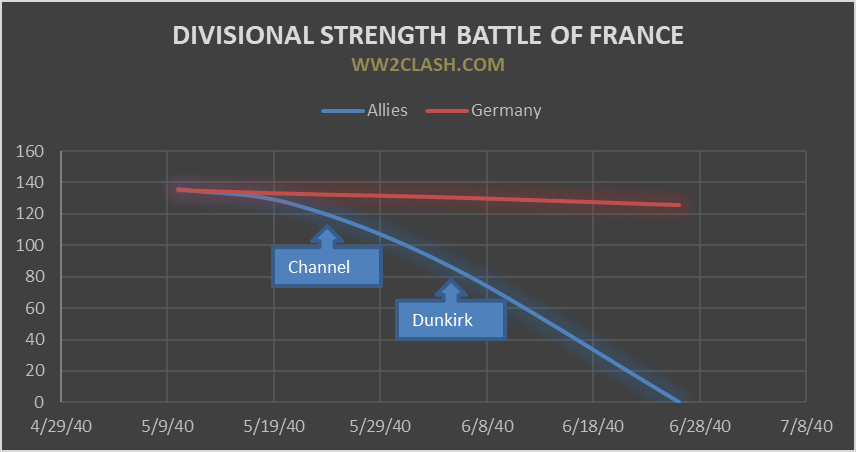
Barbarossa’s concept was similar (see the next figure). The Germans knew they would start from a position of numerical inferiority (compare the gray and red lines), but by encircling and destroying the Soviet Western Front they expected to achieve a telling numerical superiority by August and attain complete dominance during September when the wings had been cleared. After that, the last reserves would be mopped up.
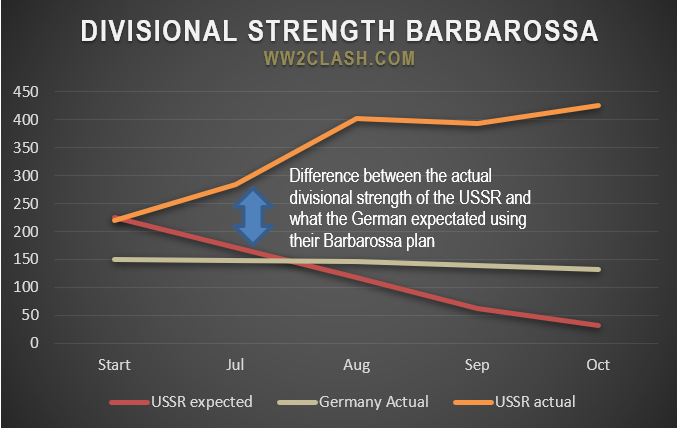
The Wehrmacht accomplished the levels of destruction that it projected, destroying a Soviet force equivalent to between 229 and 256 divisions by 31 December 1941. This should have given the Germans their expected victory since we know the Soviets deployed 220 divisions on 22 June 1941.
However, Stalin had built a large reserve and could mobilize it rapidly. From 22 June to 31 December 1941, 57 new armies appeared in the Red Army Order of Battle, and 517 new divisions were fielded.

Despite the destruction of a force equivalent to the whole Red Army deployed on 22 June 1941, the Soviet reserves ensured that the RKKA not only kept its numerical superiority but increased it throughout the year.
Contrary to what the German generals claimed, this numerical imbalance could not be redressed by simply storming towards Moscow leaving the flanks vulnerable. The original (OKW) plan achieved the destruction of at least 229 divisions. To win, the early attack on Moscow should have destroyed 245 enemy divisions in August and the same amount in September to have some days for final mop-up in October before new Red Army reinforcements arrived (see next image).
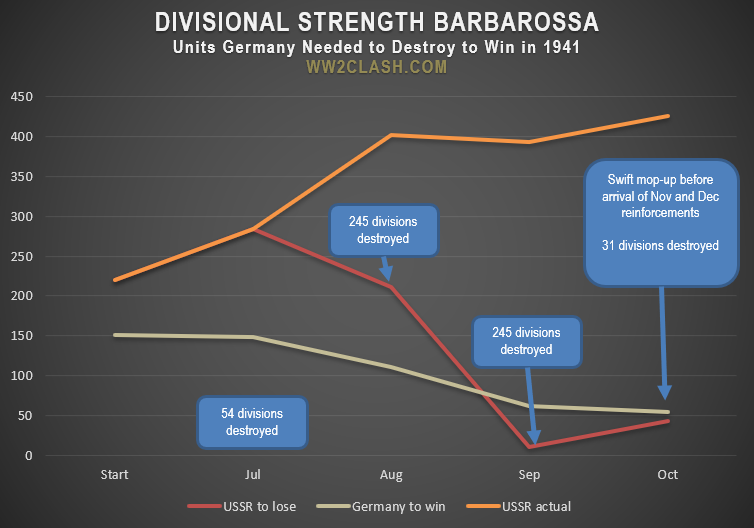
In other words, the Wehrmacht should have destroyed in one month, the same number of divisions it destroyed during the 6 months of 1941…and then it would have to repeat the same feat the following month!.
It ought to be evident that not even the Blitzkrieg could achieve such a result. The Germans should have planned for a long attrition war.
It must be said that even this implausible scenario had a narrow margin of success for two reasons. First, the cost of the Blitzkrieg was not cheap. For every 5 divisions destroyed the German army was losing one of its own. The obliteration of so many Soviet units implied that the German army would have been close to destroying itself in the process. Second, the German army should have kept just enough force to defeat the Red Army’s October reinforcements before the rainy season arrived and convince Stalin to surrender. Otherwise, the November and December reinforcements could have prolonged the war due to the weakness of the German army at that point.

